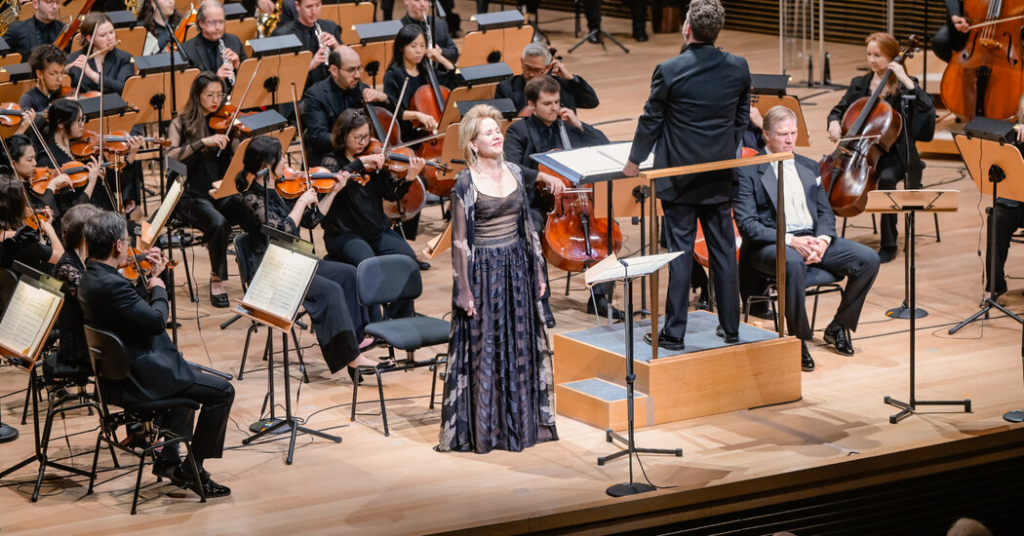Performances in N.Y.C.
Advertisement
Supported by
Brett Mitchell led the New York Philharmonic in the local premiere of a song cycle by Kevin Puts, featuring the soprano Renée Fleming.
The final weeks of an orchestra’s season can feel like the end of school: Everyone’s worn down and summer is beckoning. Last week’s program at the New York Philharmonic had that mood even before a late-breaking curveball that tested the orchestra further.
The Spanish conductor Juanjo Mena was to be on the podium for the New York debut of Kevin Puts’s “The Brightness of Light,” an orchestral song cycle featuring the soprano Renée Fleming and the baritone Rod Gilfry, along with Ravel’s rapturous “Daphnis et Chloé.”
But the Philharmonic announced on Thursday afternoon — just a day before the concerts — that Mena would not be conducting. No reason was provided, and his management did not respond to inquiries. (In January, Mena disclosed his diagnosis of early-onset Alzheimer’s disease.)
Instead, the conductor Brett Mitchell, the music director of California’s Pasadena Symphony and a newcomer to the Philharmonic, stepped in. Mitchell possesses the right credentials, having led “The Brightness of Light” at the Colorado Symphony with Fleming and Gilfry in 2019. Still, this was no easy task given his truncated rehearsal time and lack of familiarity with the players.
“The Brightness of Light” is a portrait of the artist Georgia O’Keeffe and her husband, the photographer Alfred Stieglitz. For the libretto, Puts uses selections from their correspondence — from the heady rush of their early relationship through its souring and O’Keeffe’s deepening romance with the landscape of New Mexico. (This work expands on an earlier piece with Fleming, “Letters,” that relies solely on O’Keeffe’s perspective.)
Puts, who also wrote the opera “The Hours” with Fleming in mind, adores her voice’s glowing luminosity; his orchestral writing often bathes her in shining halos of sound, and on Friday she returned the favor. Gilfry, who was also making his New York Philharmonic debut, handled Stieglitz with polish, though the role functions as little more than a foil for O’Keeffe’s personal and artistic evolution.
The music was accompanied by Wendall K. Harrington’s visuals, which included projections of work by O’Keeffe and Stieglitz, images of the couple’s letters, and libretto supertitles. Puts leans on the projections to do the storytelling; the music often feels more like accompaniment than main attraction. Still, he illustrates the couple’s complicated relationship with verve and humor, deploying rapid percussion to express the nervous, bright energy of new love, and a hacking, squawking violin solo (played by the concertmaster Frank Huang) to go with the lines “I’ve labored on the violin till all my fingers are sore — You never in your wildest dreams imagined anything worse than the notes I get out of it.” (A little on the nose, but enjoyable nonetheless.)
Then came the Ravel, played with a steely determination to get through the not-ideal circumstances. Mitchell was restrained: not quite letting the players steer “Daphnis et Chloé,” but not doing much to articulate his own vision either. Style came mainly from soloists — especially the principal flutist Robert Langevin’s shapely contributions — and from the New York Philharmonic Chorus, directed by Malcolm J. Merriweather, which leaned into Ravel’s rich tonal colors. School may be almost out, but the Philharmonic passed this particular test with grit.
New York Philharmonic
Performed Friday through Sunday at David Geffen Hall, Manhattan; nyphil.org.
Taking on ‘Salome’: For his Met Opera debut, the renowned German director Claus Guth is staging Strauss’s breakthrough opera with a focus on themes of trauma and abuse.
’Real Women Have Curves’:The new musical on Broadway is based on Josefina López’s original play and the 2002 film adaptation that starred America Ferrera.
Trapped in a Cave: Floyd Collins was pinned under a rock while exploring a cave in 1925. That history, recounted in song, is now on Broadway.
No Power? No Problem: The “Sunset Boulevard” star Nicole Scherzinger briefly entertained the crowd when “a technical malfunction on the sound side” forced the cancellation of a matinee performance.
Pushing Sisyphean Beach Balls: Celia Rowlson-Hall’s “Sissy” at the Baryshnikov Arts Center, a dance-theater hybrid featuring Marisa Tomei, pokes at the boundaries between art and life.
Advertisement
Review: New York Philharmonic, Renée Fleming and a Sub Conductor – The New York Times
